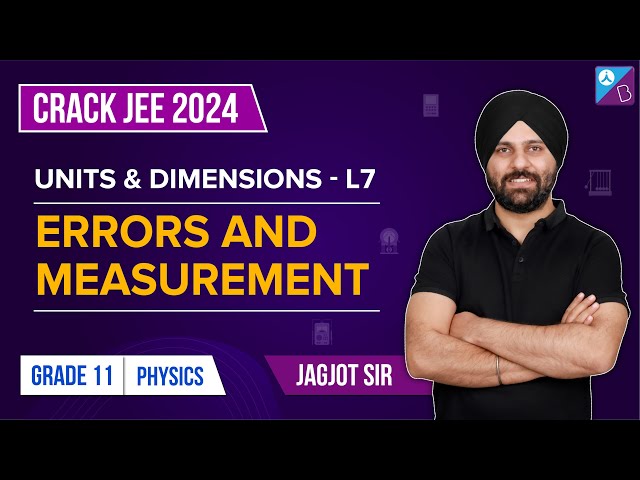To measure a physical quantity like length, mass and time, we require a standard of measurement. This standard of measurement is called the unit of that physical quantity. For example, the unit of length is metre, and a standard length of 1 metre has a precise definition. To measure the length of an object, we need to determine how many times this standard length metre is contained in the length of the object. The comparison of a physical quantity with a standard quantity is called measurement.
Download Complete Chapter Notes of Units and Measurements
Download Now
Table of Contents
- Physical Quantities
- Units
- Definition of Basic and Supplementary Units
- Dimensional Formula
- Units and Dimensions of Few Derived Quantities
- Principle of Homogeneity
- Solved Examples
- Practice Problems
- Frequently Asked Questions
Physical Quantities
Those quantities which can describe the laws of physics are called the physical quantity. A physical quantity is one that can be measured. Thus, length, mass, time, pressure, temperature, current and resistance are considered as physical quantities.
Classification of Physical Quantities
The physical quantities are classified into
(i) Fundamental quantities or base quantities
(ii) Derived quantities
The physical quantities that are independent of each other are called fundamental quantities. All the other quantities which can be expressed in terms of the fundamental quantities are called the derived quantities.
Units
The reference standard used to measure the physical quantities is called the unit.
Properties of Unit
- The unit should be of some suitable size
- The unit must be well-defined
- The unit should be easily reproducible, i.e., it should not change with place
- The unit must not change with time
- The unit should not change with physical conditions like temperature, pressure, etc.
- The unit must be easily comparable experimentally with similar physical quantities.
Types of Units
(i) Fundamental Units
The units defined for the fundamental quantities are called fundamental units.
(ii) Derived Units
The units of all other physical quantities which are derived from the fundamental units are called the derived units.
System of Units
(1) FPS System: In this system, the unit of length is foot, the unit of mass is pound, and the unit of time is second.
(2) CGS System: In this system, the units of length, mass and time are centimetre, gram and second, respectively.
(3) MKS System: In this system, the unit of length, mass and time are meter, kilogram and second, respectively.
(4) SI System: This system is widely used in all measurements throughout the world. The system is based on seven basic units and two supplementary units.
| Basic Units | ||
|---|---|---|
| Quantity | Unit | Symbol of the Unit |
| Length | metre | m |
| Mass | kilogram | kg |
| Time | second | s |
| Temperature | kelvin | K |
| Electric current | ampere | A |
| Number of particles | mole | mol |
| Luminous intensity | candela | cd |
| Supplementary Units | ||
| Plane angle | radian | rad |
| Solid angle | Steradian | sr |
Definition of Basic and Supplementary Units
Basic Units
1. Metre (m): One metre is the distance travelled by light in the vacuum during a time interval of (1/299792458) seconds.
2. Kilogram (kg): It is the mass of a platinum-iridium cylinder kept at the National Bureau of Weights and Measurements, Paris.
3. Second (s): The second is the time taken by the light of a specified wavelength emitted by a caesium-133 atom to execute 9192631770 vibrations.
4. Ampere (A): One ampere is that current which, when passed through two straight parallel conductors of infinite length and of negligible cross-section kept at a distance of 1 metre apart in the vacuum, produces between them a force equal to 2 x 10-7 newton per metre length.
5. Kelvin (K): It is the fraction 1/273.6 of the thermodynamic temperature of the triple point of water.
6. Candela (cd): A candela is defined as 1/60 th of the luminous intensity of 1 square centimetre of a perfect black body maintained at the freezing temperature of platinum (1773 0C).
7. Mole (md): One mole is the amount of substance that contains elementary units equal to the number of atoms in 0.012 kg of carbon-12.
Supplementary Units
1. Radian (rad): The radian is the angle subtended at the centre of the circle by the arc whose length is equal to the radius of the circle.
2. Steradian (Sr): The steradian is the solid angle subtended at the centre of a sphere by a spherical surface of an area equal to the square of its radius.
Dimensional Formula
The dimensional formula of any physical quantity is the formula that tells which of the fundamental units have been used for the measurement of that physical quantity.
How is dimensional formula written for a physical quantity?
(1) The formula of the physical quantity must be written. The quantity must be on the left-hand side of the equation.
(2) All the quantities on the right-hand side of the formula must be written in terms of fundamental quantities like mass, length and time.
(3) Replace mass, length and time with M, L and T, respectively.
(4) Write the powers of the terms.
Characteristics of Dimensions
(1) Dimensions do not depend on the system of units.
(2) Quantities with similar dimensions can be added or subtracted from each other.
(3) Dimensions can be obtained from the units of the physical quantities and vice versa.
(4) Two different quantities can have the same dimension.
(5) When two dimensions are multiplied or divided, it will form the dimension of the third quantity.
Dimensional Analysis
The dimensional formula can be used to
(1) Check the correctness of the equation.
(2) Convert the unit of the physical quantity from one system to another.
(3) Deduce the relation connecting the physical quantities.
Units and Dimensions of a Few Derived Quantities
| Physical Quantity | Unit | Dimensional Formula |
| Displacement | m | M0L1T0 |
| Area | m2 | M0L2T0 |
| Volume | m3 | M0L3T0 |
| Velocity | ms-1 | M0L1T-1 |
| Acceleration | ms-2 | M0L1T-2 |
| Density | Kg m-3 | M1L-3T0 |
| Momentum | Kg ms-1 | M1L1T-1 |
| Work/Energy/Heat | Joule (or) Kg m2/sec2 | M1L2T-2 |
| Power | Watt (W) (or) Joule/sec | M1L2T-3 |
| Angular Velocity | rad s-1 | M0L0T-1 |
| Angular Acceleration | rad s-2 | M0L0T-2 |
| Moment of Inertia | Kg m2 | M1L2T0 |
| Force | Newton (or) Kg m/sec2 | M1L1T-2 |
| Pressure | Newton/m (or) Kg m-1/sec2 | M1L-1T-2 |
| Impulse | Newton sec (or) Kg m/sec | M1L1T-1 |
| Inertia | Kg m2 | M1L2T0 |
| Electric Current | Ampere (or) C/sec | QT-1 |
| Resistance/Impedance | Ohm (or) Kg m2/sec C2 | ML2T-1Q-2 |
| EMF/Voltage/Potential | Volt (or) Kg m2/sec2 C | ML2T-2Q-1 |
| Permeability | henry/m (or) Kg m/C2 | MLQ-2 |
| Permittivity | Farad/m (or) sec2C2/Kgm3 | T2Q2M-1L-3 |
| Frequency | Hertz (or) sec-1 | T-1 |
| Wavelength | m | L1 |
Principle of Homogeneity
According to the principle of homogeneity of dimensions, all the terms in a given physical equation must be the same.
Ex. s = ut + (½) at2
Dimensionally
[L] = [LT-1.T] + [LT-2. T2] [L] = [L] + [L]Defects of Dimensional Analysis
- While deriving the formula, the proportionality constant cannot be found.
- The equation of a physical quantity that depends on more than three independent physical quantities cannot be deduced.
- This method cannot be used if the physical quantity depends on more parameters than the number of fundamental quantities.
- The equations containing trigonometric functions and exponential functions cannot be derived
Points to Remember
- Those quantities which can describe the laws of physics are called the physical quantity. Example: length, mass and time.
- Physical quantities can be classified as fundamental quantities and derived quantities.
- The reference standard used to measure the physical quantities is called the unit. Units are classified as fundamental units and derived units.
- The SI system is the most commonly used system of units
- The SI is based on seven basic units and two supplementary units.
- The dimensional formula of any physical quantity is the formula that tells which of the fundamental units have been used for the measurement of that physical quantity.
- The dimensional formula follows the principle of homogeneity
Solved Examples
(1) The diameter of a cylinder is measured using vernier callipers with no zero error. It is found that the zero of the vernier scale lies between 5.10 cm and 5.15 cm of the main scale. The vernier scale has 50 divisions equivalent to 2.45 cm. The 24th division of the vernier scale exactly coincides with one of the main scale divisions. Then, the diameter of the cylinder is
a) 5.112 cm
b) 5. 124 cm
c) 5.136 cm
d) 5.148 cm
Answer: b) 5. 124 cm
Solution:
The least count of a vernier is given by
L.C. = 1 Main scale division/Number of divisions on the vernier scale
L.C. = 1 M.S.D./n
One main scale division = 0.05 cm
n = 50
L.C. = 0.05/50 = 0.001 cm
Diameter of the cylinder = Main scale reading + (Least count x Vernier scale reading)
= 5.10 + (24 x 0.001) = 5.124 cm
(2) The density of a solid ball is to be determined in an experiment. The diameter of the ball is measured with a screw gauge, whose pitch is 0.5 mm, and there are 50 divisions on the circular scale. The reading on the main scale is 2.5 mm, and that on the circular scale is 20 divisions. If the measured mass of the ball has a relative error of 2%, the relative percentage error in the density is
a) 0.9%
b) 2.4 %
c) 3.1 %
d) 4.2 %
Answer: c) 3.1 %
Solution:
Given,
Pitch = 0.5 mm
Circular scale division = 50
Main scale division = 2.5 mm
Least count = Pitch/Circular scale division= 0.5/50 = 0.01 mm
Circular scale division reading = 20
Relative error = 2%
Screw gauge reading = Main scale reading + (Least count x Circular scale division reading)
= 2.5 + (0.01 x 20)
= 2.7 mm
Density, ρ = mass/volume
The relative percentage error in density is
= 3.1%
(3) The dimensional formula for the relative refractive index is
a) [M0L1T-1]
b) [M0L0T0]
c) [M0L1T1]
d) [MLT-1]
Answer: b) [M0L0T0]
Solution:
The relative refractive index is the ratio of the refractive index of the medium to the refractive index of the vacuum. Hence, it is a dimensionless quantity.
(4) A thin copper wire of length l metre increases in length by 2% when heated through 10°C. What is the percentage increase in the area when a square copper sheet of length l metre is heated through 10°C?
a) 4%
b) 8%
c) 16%
d) None of these
Answer: a) 4%
Solution:
△l = l αΔT
△l/l = 2/100 = α x 100
α = 2/1000
β = 2α = 4/1000
△A = A βΔT
△A/A = βΔT
= (4/1000) x 10
= 4/100
Percentage increase in area = (4/100) x 100
= 4%
(5) The period of oscillation of a simple pendulum in the experiment is recorded as 2.63 s, 2.56 s, 2.42 s, 2.71 s and 2.80 s, respectively. The average absolute error is
a) 0.1 s
b) 0.11 s
c) 0.01 s
d) 1.0 s
Answer: b) 0.11 s
Solution:
Average value = (2.63 + 2.56 + 2.42 + 2.71 + 2.80)/5
= 2.62 sec
Now,
|△T1| = 2.63 – 2.62 = 0.01
|△T2| = 2.62- 2.56 = 0.06
|△T3| = 2.62- 2.42 = 0.20
|△T4| = 2.71- 2.62 = 0.09
|△T4| = 2.80- 2.62 = 0.18
Mean absolute error,
= (0.01 + 0.06 + 0.20 + 0.09 + 0.18)/5
= 0.54/5 = 0.108 = 0.11 sec
Recommended Videos
Units & Dimensions – Vernier Calliper’s

Units & Dimensions – Screw Gauge

Units & Dimensions – Important Questions

Units & Dimensions – Introduction Concepts

Units and Dimensions – Lesson 5

Units & Dimensions – SI System and Parallax

Units and Dimensions – Lesson 7

Units and Measurements Class 11 Important JEE Questions

Practice Problems
(1) Two full turns of the circular scale of a screw gauge cover a distance of 1 mm on its main scale. The total number of divisions on the circular scale is 50. Further, it is found that the screw gauge has a zero error of –0.03 mm. While measuring the diameter of a thin wire, a student notes the main scale reading of 3 mm and the number of circular scale divisions in line with the main scale as 35. The diameter of the wire is
a) 3.32 mm
b) 3.73 mm
c) 3.67 mm
d) 3.38 mm
(2) To find the distance d over which a signal can be seen clearly in foggy conditions, a Railway Engineer uses dimensional analysis and assumes that the distance depends on the mass density ρ of the fog, intensity (power/area) S of the light from the signal and its frequency f. The Engineer finds that d is proportional to S1/n. The value of n is
a) 2
b) 3
c) 1
d) 4
(3) The energy (E), angular momentum (L) and universal gravitational constant (G) are chosen as fundamental quantities. The dimensions of the universal gravitational constant in the dimensional formula of Planck’s constant (h) is
a) zero
b) -1
c) 5/3
d) 1
(4) The current-voltage relation of the diode is given by I = (e1000V/T – 1) mA, where the applied V is in volts, and the temperature T is in degree, Kelvin. If a student makes an error measuring ±0.01 V while measuring the current of 5 mA at 300K, what will be the error in the value of current in mA?
a) 0.2 mA
b) 0.02 mA
c) 0.5 mA
d) 0.05 mA
(5) A student performs an experiment to determine Young’s modulus of a wire, exactly 2 m long, by Searle’s method. In a particular reading, the student measures the extension in the length of the wire to be 0.8 mm with an uncertainty of ± 0.05 mm at a load of exactly 1.0 kg. The student also measures the diameter of the wire to be 0.4 mm with an uncertainty of ± 0.01 mm. Take g = 9.8 ms-2 (exact). The Young’s modulus obtained from the reading is
a) (2 ± 0.3) x 1011 N/m2
b) (2 ± 0.2) x 1011 N/m2
c) (2 ± 0.1) x 1011 N/m2
d) (2 ± 0.05) x 1011 N/m2
Frequently Asked Questions
Define the SI unit of current.
The SI unit of current is Ampere. One ampere is that current which, when passed through two straight parallel conductors of infinite length and of negligible cross-section kept at a distance of 1 metre apart in the vacuum, produces between them a force equal to 2 x 10-7 newton per metre length.
Name the physical quantities whose units are ohm and Hertz.
The physical quantities whose units are ohm and Hertz are resistance and frequency, respectively.
What are the types of units?
Fundamental units and derived units.
A vernier calliper is used to measure the mean diameter of a thin brass rod. Why is a set of 50 measurements more accurate than a set of 5 measurements?
Random errors can be reduced by increasing the number of measurements.
Which of the following is not a unit of time?
(a) Second
(b) Parsec
(c) Year
(d) Light Year
(b) Parsec and (d) Light Year
Solution:
Parsec and Light Year are units to measure large distances. For example, the distance between the sun and the earth or other celestial bodies. So, they are the units of length and not time.
Comments